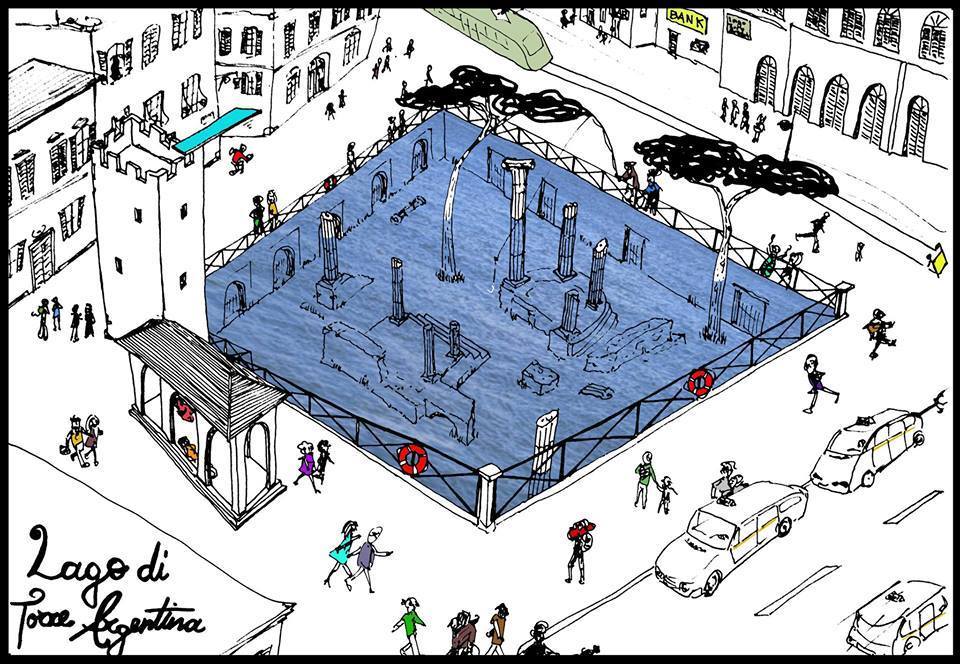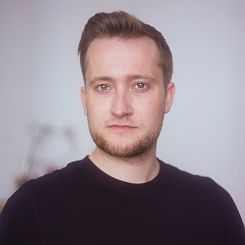Interview with Fabian Saul
"Prying the streets open to look inside”

Fabian Saul is an ambler.
For the past five years he has scoured the streets of Europe in search of a binding element: Traces of resistance.
For your project „Traces of Resistance“, you’ve been travelling to different places and ambling there. Is ambling comparable to walking?
 © Malte Seidel
Walking and ambling are very different. Walking is by and large a middle-class activity that has to do with recovering on Sunday in order to be operational again on Monday. Ambling is not edifying, it takes you to dark places, both in the urban environment and within yourself. Walking is not particularly subversive, but the process of ambling is. Taking time to amble is a deliberate provocation because you aren’t being productive and have no specific destination. But also because you perceive things from an observer’s position. Someone without a specific destination who doesn’t conform to the orchestrated order of a city quickly arouses suspicion.
© Malte Seidel
Walking and ambling are very different. Walking is by and large a middle-class activity that has to do with recovering on Sunday in order to be operational again on Monday. Ambling is not edifying, it takes you to dark places, both in the urban environment and within yourself. Walking is not particularly subversive, but the process of ambling is. Taking time to amble is a deliberate provocation because you aren’t being productive and have no specific destination. But also because you perceive things from an observer’s position. Someone without a specific destination who doesn’t conform to the orchestrated order of a city quickly arouses suspicion.
Observer and suspect cannot be told apart in the ambling process.
How do you proceed when you discover a new street?
The process is very intuitive; there is no modus operandi. You tend to think of a street as being linear: You walk from A to B to get to work or to the supermarket – that’s how streets are mostly used.
But this is very oversimplified. Let’s take a concrete example: The „Traces of Resistance“ project started in the Kantstraße in Berlin. I set off there and started collecting small fragments.
"ALL OF A SUDDEN PLACES THAT YOU WOULD USUALLY JUST WALK PAST BECOME MORE COMPLEX AND LITTLE BY LITTLE STREETS BECOME AN AMPLE COLLECTION OF OVERLAPPING STORIES"
What kinds of fragments are there for example?
There was this ugly 60s hotel for instance, an utterly unspectacular place. However, I had discovered a letter from Iranian author, Sadegh Hedayat. In the 20s he was at the spot where this hotel was later built and wrote about how much he loved that street and how he wanted to open a bookshop there.
And all of a sudden this place was loaded with a completely different meaning. Later on I also met an Iranian dissident in the Kantstraße. He was one of the first people who started writing about American literature after the Islamic revolution in Teheran and was sentenced to an employment ban and lashings. He was able to flee with the aid of German publishing house, Suhrkamp Verlag, and ended up in Berlin. He then came up with the idea of opening a bookshop in the Kantstraße after reading the very same letter by Hedayat. I met him some 500 meters away from the hotel in a small discrete bookshop, also called „Hedayat“.
Suddenly, places like this bookshop and hotel that you normally just walk past become far more complex and you start discovering tightly knit links in space and time. And that’s how the street slowly becomes an ample collection of overlapping stories, and by that I mean real-life stories, as if you were to pry the streets open and look inside.
Your project is about finding traces of resistance. Why exactly did you pick the topic of resistance?
It’s not like I said to myself: Resistance would make an interesting topic, why don’t I do some research on it. I just started collecting these stories on the streets. And at some point I asked myself: What connects all of these little stories? And I got the impression that the actual core of this connection is in fact resistance and that this is the common theme that loosely holds all fragments together.
What kind of resistance are we talking about here?
Resistance usually sounds like proactive and upfront political activism. That’s definitely a part of it. But we’re looking at various forms of resistance here. There are many more passive forms, many peformative and artistic forms. This project enables a connection between hyper-local attention to detail in the street microcosm on one hand, and resistance on the other.
Regardless as to whether the actual topic is post-colonial order or gentrification, or the simple question of who is visible in the urban environment and who isn’t.
You’ve just come back from your first research trip in Great Britain and Ireland. What were your criteria for picking these individual places?
In general, I can’t say beforehand what street I’ll pick. The end result is often quite dull. It’s not like I look for a street that represents a certain place.
The street doesn’t represent the town.
Not at all, and it can be very disappointing if you expect this to be the case. This time I started in Dublin and walked back and forth along the river. What fascinated me is the sheer diversity of areas that can be seen from the riverside. From that vantage point, the urban landscape is extremely fragmented, on an architectural level. There is no regard for harmony and uniformity in that respect. And from the port of Dublin, a short circumnavigation around the coast will take you to the port of Belfast.
Where you also went.
Yes, but first I took the M1 and then the A1 to Newry. Up there you’re in the Northern Ireland environment where the streets are covered in writing and you’re surrounded at all times by posters and placards recounting historical events. And most of all, by memorials, crosses and graves. The streets there are a place of permanent mourning, but with a political agenda of course.
And where did you go next?
I then went to the port of Belfast. They’ve developed a Titanic narrative over there since Belfast was the town where the Titanic was built. There’s a Titanic walk, a Titanic tour, a Titanic memorial and a Titanic museum. The town is trying to create a story that predates the Troubles and takes you back to the golden age of shipbuilding, but at the same time it focuses on the story of a sunken ship. These are the first small fragments of what I’m interested in. It also becomes evident how literary this approach is, not to be confused with the kind of storytelling found in journalism.
„NATIONAL STORIES ARE VERY DOMINANT, SUCCESSFUL STORIES. THE BEST WAY OF PRYING THESE NARRATIVES OPEN IS BY TELLING THE STORY DIFFERENTLY“.
And what is your intention?
It isn’t about adopting a nostalgic approach, as seen in 19th century ambling. It’s really about the question: Is there emphatic potential in telling a story in this way? I think there is. I believe that in this era of globalisation this can be a very interesting alternative to nationalist storytelling, when it comes to bringing people together. The book project „Traces of Resistance“ is to a certain extent a pan-European story; hence not a European one that stops at the Mediterranean, but one that stretches beyond it. I am also trying to include Russia and North Africa.
What made you choose this geographical area and not limit yourself to Europe?
You can’t write about Marseille without also writing about Algiers. In order to understand Berlin you need to talk about Moscow. My reaction also has to do with the state of Europe. We’ve started reiterating stories that date back to before WW2, or even the early 19th century in some cases.
National stories are very dominant, successful stories. The best way of prying these narratives open is by telling the story differently. „Traces of Resistance“ is in the broadest sense a European story with a different approach. There have been many attempts, where people have said: We need to talk like the people who have been successful so far. Just like when politicians say: We need to adopt more points from our opponents’ agenda in order to get more votes. But that’s a trap. And in the same way, it’s a narrative trap to think that you can make a great European story based on national narratives and that people will immediately be able to relate to it.